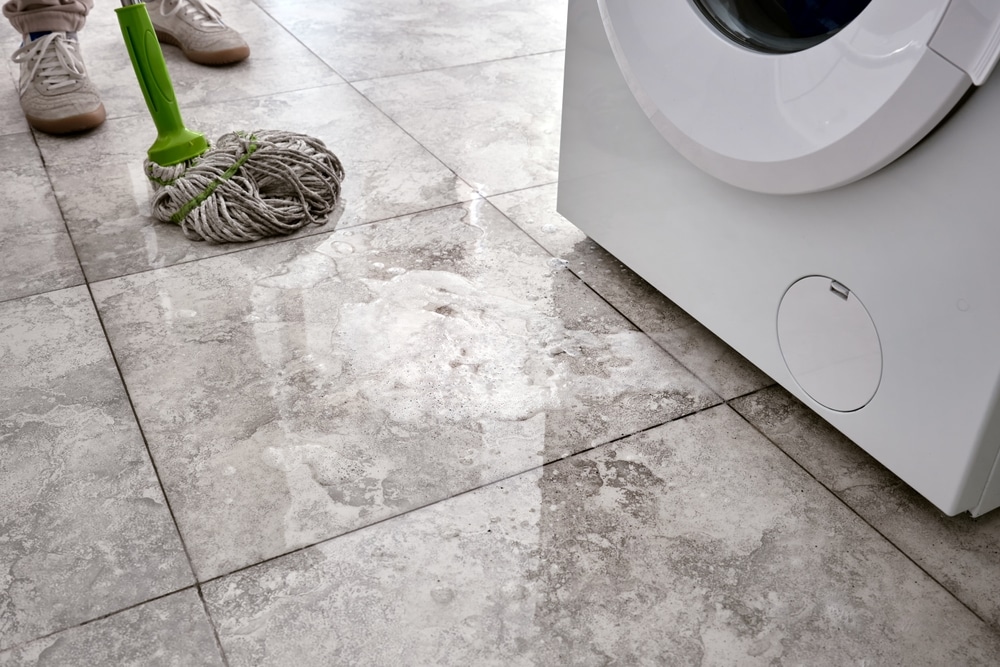Is your washing machine leaking and disrupting your daily routine? You’re not alone; it’s a common problem that many homeowners face. The good news is that with the right information, you can pinpoint the source, address the issue, and protect your home from costly water damage.
Even a small leak can quickly escalate, damaging floors, walls, and your home’s structure. The sooner you identify where the water is coming from, the easier it is to fix the problem and prevent long-term issues.
This guide will walk you through the most common leak locations and what they mean, how to handle simple fixes yourself, and when to call a water damage restoration specialist. You’ll also read about preventive tips from certified technicians so you can keep your washer running smoothly and leak-free.
Table of Contents
Understanding Leak Locations & What They Mean
Finding the source of a leaking washing machine helps determine its size and severity. A washer can leak from the bottom, front, back, or even the top, and each location points to different causes.
In many cases, the cause is a damaged, clogged, or disconnected hose responsible for water transport or drainage. Fortunately, most of these problems are relatively easy to fix with the right tools and a bit of know-how.
Bottom Leaks
Noticed water pooling underneath your washer? A washer leaking from the bottom usually points to one of a few common issues:
- Clogged drain hose – When the drain hose is blocked, water can back up during the spin or drain cycle.
- Water pump problems – A cracked or worn-out pump housing can let water escape mid-cycle.
- Worn tub seal – This seal, located where the tub connects to the transmission, can wear out over time and cause a slow, steady leak.
- Faulty water level switch – If the switch isn’t working properly, your washer might overfill and overflow.
A washing machine leaking from the bottom typically requires repair from a water damage restoration specialist.
Front Leaks
Water on the floor directly in front of your washer may indicate:
- Door gasket issues – On front-load washers, a worn or torn rubber seal lets water seep out.
- Overloading – Excess laundry loads can push water past the door seal.
- Overflow tube clogs – Blocked tubes redirect water where it shouldn’t go.
- Over-sudsing – Using too much detergent creates excessive suds, forcing water out.
If you have a front leak, first inspect your seal for any damage. If there is no visible damage, clean and rerun your washer to see if the leak continues.
To avoid potential front leaks, regularly clean the door gasket to remove lint, soap scum, and debris.
Back & Top-Side Leaks
A washing machine leaking from the rear or near the top is often a sign of:
- Loose hose connections – Especially common after moving the appliance.
- Loose inlet valve – Can drip even when the machine isn’t running.
- Misaligned drain hose – If it’s not positioned correctly, water can spill during draining.
If you suspect loose or unsecured hoses, gently pull the washer forward to inspect them. Check that the drain hose is fully inserted and tightly secured. If it’s still leaking, the drainpipe itself may be clogged.
For the fill hoses, turn off the water supply, remove the hoses, and inspect the rubber washers inside. Worn or missing washers should be replaced, and if the leak persists, you may need to replace the hose entirely.
Should You Fix the Leak Yourself?
Some washing machine leaks, such as loose hose connections or a clogged filter, are simple enough for a quick DIY fix. Tightening a hose or clearing a blockage takes only a few minutes.
However, leaks coming from underneath the washer often signal more complex issues, such as damaged seals, faulty pumps, or electrical problems. These types of repairs are best left to a water damage restoration specialist. They’ll help identify hidden moisture in walls, floors, and baseboards before it leads to mold or structural issues.
Washing Machine Troubleshooting Tips
If your washing machine is leaking, you can run through a few simple checks to help identify the source before calling for service.
Here are some helpful maintenance tips:
- Use your machine’s built-in diagnostics to run regular system checks.
- Monitor your home’s water pressure. Sudden spikes can put stress on hoses and valves.
- Log maintenance and track performance over time using your washer’s companion app.
Pro tip: When you need professional help for a leak, schedule a water damage inspection with Cleanup and Total Restoration.
Preventive Measures for Washing Machine Leaks
The best way to deal with a leaking washing machine is through routine preventative care. There are a few simple precautions that can save you from costly water damage and unexpected appliance downtime.
- Inspect hoses regularly: Check both supply and drain hoses every few months for cracks, bulges, rusted fittings, or water stains behind the machine. It’s a good idea to replace hoses every few years to prevent sudden leaks.
- Keep the machine level: An uneven washer can vibrate excessively, loosening connections and putting stress on internal seals. Adjust the legs as needed and use a level to ensure stability.
- Use the right detergent: Always use HE (high-efficiency) detergent for front-load washers, and follow the manufacturer’s recommended amount. Too much detergent can cause oversudsing, which may lead to leaks around the door or drawer.
- Clean the door gasket and detergent drawer: Lint, soap scum, and mold can build up around the door seal and detergent compartment, weakening their water-tight seal. Wipe these areas down weekly to prevent leaks and odors.
- Don’t overload the washer: Overloading puts unnecessary pressure on internal components like seals, bearings, and hoses. Stick to your washer’s load capacity to avoid long-term wear and leaks.
- Check for signs of water damage: Look for signs of baseboard water damage, peeling paint, or stains around and behind your washer. These could be signs of a slow or hidden leak that needs immediate attention.
When To Call a Professional Technician
Tried one too many DIY attempts to fix that washing machine leaking in your home? If nothing’s worked, it’s time to call in the professionals before the issue gets worse.
While minor leaks can sometimes be handled on your own, you should call a professional immediately if:
- The washing machine leak is coming from the drum or motor area
- You notice burning smells or electrical sparks
- Water has spread to surrounding floors, walls, or nearby rooms.
At Cleanup & Total Restoration, we understand how stressful a leak can be. That’s why our certified technicians are available 24/7, with response times of 60 minutes or less. We offer upfront, honest pricing and full-service solutions, from water extraction to complete mold removal.
If your washing machine is leaking and you’re unsure how far the damage has spread, our water damage restoration experts can identify hidden moisture, prevent further damage, and restore your home safely. Contact us today for a FREE Estimate.
Frequently Asked Questions
How do I know if the tub seal is causing my washer to leak?
A failing tub seal often causes water to pool directly under the machine during or after a wash cycle. You may also notice rust spots, water mixed with grease, or dripping from underneath the washer.
Why is my washing machine leaking when it’s not in use?
If you see water on the floor even when the washer is off, it likely indicates a faulty water inlet valve, loose supply hose connections, or leaks from internal plumbing.
Turn off the water supply to the machine immediately and contact a technician to prevent ongoing water damage.
Why is my washing machine leaking during the drain cycle?
Leaks that appear only during the drain cycle are often linked to a cracked or clogged drain hose, loose hose clamps, or a failing water pump.









